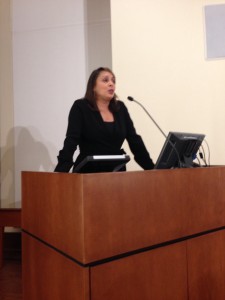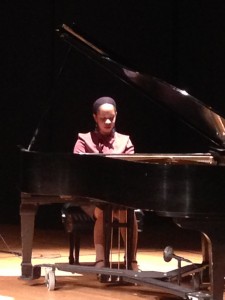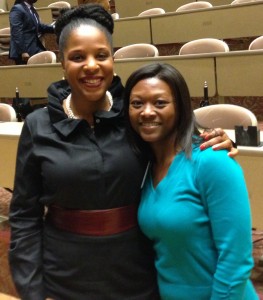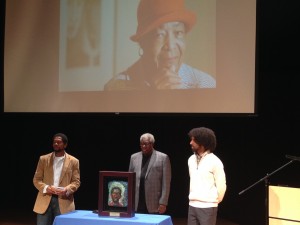In Part 4, Pablo asks what I was doing now that my book Living with Lynching was doing its work in the world. We were speaking in August 2012, so I mentioned Black LIT Radio; my essay “James Baldwin, Performance Theorist, Sings the Blues for Mister Charlie;” and my involvement in Black Girls RUN!, founded by Toni Carey and Ashley Hicks. I also shared my vision for a mentoring program that connects OSU English alumni and current students and mentioned that I’m on Twitter @ProfKori.
Callaloo Conference 2014
The 2014 Callaloo conference was too full of memorable moments to attempt anything close to a recap. Still, I can’t resist sharing a few personal highlights.

Natasha Trethewey, two-term Poet Laureate of the United States, paying tribute to Dr. Charles Rowell, founding editor of Callaloo
I moderated the opening ceremonies, during which Dr. Charles Rowell reminded us of his reasons for making the conference an annual event in 2008 and working so tirelessly to continue the tradition. Natasha Trethewey welcomed us to Emory University and shared how important Callaloo has been to her extraordinary journey.
The centerpiece of the opening night was a dramatic reading of The Ballad of Emmett Till by its author. Ifa Bayeza brought her poetic drama to life, presenting Emmett Till as a teenager with a strong sense of self. While most of the 140+ works about Till focus on his mother’s courage or his iconic status, Bayeza puts his personality front and center.
That night, I had the pleasure of talking not only with Ifa Bayeza but also with Howard Dodson, who offered a keynote the next day. He reminded us that archives don’t simply hold documents; they hold a people’s “memories, knowledge, actions, behaviors.” This very much resonated for me because Living with Lynching uses archival evidence to identify embodied practices of belonging. And, much of my archival evidence was found at the Schomburg Center for Research in Black Culture and the Moorland-Spingarn Research Center, institutions where his leadership has been indispensable.
My research has also benefited from interactions with Randall Burkett, Curator at Emory University’s Manuscripts and Rare Book Library (MARBL). He had been my main host when I conducted research at MARBL in 2008, and he joined us for the entire conference. Callaloo conference conversations were also enriched by the participation of Pellom McDaniels, III, whose work at MARBL is clearly having an impact. In the closing keynote, Barbara Chase-Riboud shared that her papers are now with MARBL and will be immediately available.
Another highlight was meeting novelist Tayari Jones in person. I have taught her work with much joy and success, and I interviewed her when I was doing Black LIT Radio, but I had never actually been in her energetic presence. This was a special treat because I not only heard her read from Silver Sparrow and witnessed a more formal presentation about her process for writing Leaving Atlanta, but I also got to hear about the book she’s finishing now. I can already tell I will be as engrossed by it as I was by Silver Sparrow.

Dr. Courtney Bryan playing original composition in honor of pioneering art historian Dr. Samella Lewis
The last day of the conference, attendees paid special tribute to Dr. Charles Rowell in many ways, including rousing renditions of several versions of “Happy Birthday.” But as much as we wanted to shower him with praise, Dr. Rowell continued to do what he always has: ensure that the great minds of the African Diaspora recognize each other. We celebrated the foundational work of Dr. Samella Lewis, the first Black woman to earn a PhD in Art History and a scholar whose seminal works make the study of African American Art History possible. Courtney Bryan played an original piano composition in her honor, and professor and painter Sedrick Huckaby presented an original painting to her grandson Unity Lewis (on her behalf) as the inaugural Callaloo Art prize.
A truly amazing several days! I feel blessed to have been a part of it! (For the full program, click here.)




